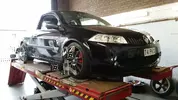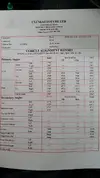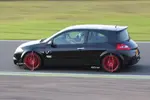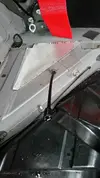papps
Well-Known Member
Good to have this all in one place, as its asked often! 
This covers a basic guide for how to set up your BC Coilovers for the Mk2 Megane for mixed Road and Track Use.
1. Geometry

Only the Fronts are adjustable on the Megane from a geometry point of view......So the only 2 things that you should be concerned with are:
a) Camber and
b) Toe....
Camber
A more road bias set up should have -2 Negative Camber on each side, you'll have less 'tram-lining' than with OEM cup suspension on the road to worry about due to the coilovers effectiveness in putting down the power...this is also perfect for someone who maybe does 3 or 4 trackdays a year....
For a more experienced track driver, -2.5 will be the maximum front Camber you'd want to run, with it still being useable on the road, any more than this, and you enter 'track only' territory - I'd start with -2.0 and dial in more as you start to see the sidewall of your tyre wearing, bear in mind, that to utilise the -2.5 or -3 of camber, you'd need to be on the cornering limits of the car more often....
Toe
Some say this is done to choice and preference, but I'm of the school of thought that you need to run some negative toe, to fully utilise the cornering ability of your Mk2 Meg.
With 0 Toe, you'll have the car its most stable on the brakes, no arse twitching at all, but you'll have to fight more at the turn in..leading to turn in understeer.....
With -5 (-0.6mm on an 18" Wheel) minutes on each side (-10 minutes total) you'll have a sharper turn in and be able to get on the power earlier, but you'll have to work to get the most out of the car under braking - only an issue on track.
For reference a MK3 Clio Cup Race car will run -10 minutes toe on each side, (-20 minutes in total) - this is part of the reason (along with the really stiff rear springs) why they have such a fantastic and agile turn in....
I would suggest -5 minutes on each side, so -10 in total for a mixed use vehicle to start with, and then tweak as you see fit.
Here's a printout of -2 Camber and -5 Minutes Toe on each side - my recommended intitial settings:

2. Ride Height
This is not an exact science, but as a general rule of thumb you'll want to keep the following in mind.....
The rear of the car should always be higher than the front, this is to balance the car and kill most of the understeer you'd expect from a car that has most of the weight over the front axle...
Myself, and many other Mk2 Megane users have found running the rear 10mm higher than the front works well....
Measuring from the ground, through the centre of the wheel, to the bottom of the wheel arch you should be aiming for 650mm ride at the front and 660mm at the rear....
This will work on the road, you'll be able to clear standard speed bumps, the island humps (to allow large emergency vehicles through) need a little more care and to take a wheel over the middle part of them..
This ride height has been extensively tested through some of Scotlands most severe compressions without any bottoming out issues....

3. Damper Settings:
The part that will take the longest time for you to find the balance for your own driving technique and the track conditions on the day....
For the Road, I would suggest 3/30 clicks front and 5/30 clicks rear to start with....
For the Track on 'Street' spring rates I would suggest 8/30 clicks front and 15/30 clicks rear to start with on a dry day.
For track usage on the 'track' spring rates I would try 15/30 clicks all round as a starting point.

Feel free to post your BC Coilover set-ups below and whats worked well for you.
This covers a basic guide for how to set up your BC Coilovers for the Mk2 Megane for mixed Road and Track Use.
1. Geometry

Only the Fronts are adjustable on the Megane from a geometry point of view......So the only 2 things that you should be concerned with are:
a) Camber and
b) Toe....
Camber
A more road bias set up should have -2 Negative Camber on each side, you'll have less 'tram-lining' than with OEM cup suspension on the road to worry about due to the coilovers effectiveness in putting down the power...this is also perfect for someone who maybe does 3 or 4 trackdays a year....
For a more experienced track driver, -2.5 will be the maximum front Camber you'd want to run, with it still being useable on the road, any more than this, and you enter 'track only' territory - I'd start with -2.0 and dial in more as you start to see the sidewall of your tyre wearing, bear in mind, that to utilise the -2.5 or -3 of camber, you'd need to be on the cornering limits of the car more often....
Toe
Some say this is done to choice and preference, but I'm of the school of thought that you need to run some negative toe, to fully utilise the cornering ability of your Mk2 Meg.
With 0 Toe, you'll have the car its most stable on the brakes, no arse twitching at all, but you'll have to fight more at the turn in..leading to turn in understeer.....
With -5 (-0.6mm on an 18" Wheel) minutes on each side (-10 minutes total) you'll have a sharper turn in and be able to get on the power earlier, but you'll have to work to get the most out of the car under braking - only an issue on track.
For reference a MK3 Clio Cup Race car will run -10 minutes toe on each side, (-20 minutes in total) - this is part of the reason (along with the really stiff rear springs) why they have such a fantastic and agile turn in....
I would suggest -5 minutes on each side, so -10 in total for a mixed use vehicle to start with, and then tweak as you see fit.
Here's a printout of -2 Camber and -5 Minutes Toe on each side - my recommended intitial settings:

2. Ride Height
This is not an exact science, but as a general rule of thumb you'll want to keep the following in mind.....
The rear of the car should always be higher than the front, this is to balance the car and kill most of the understeer you'd expect from a car that has most of the weight over the front axle...
Myself, and many other Mk2 Megane users have found running the rear 10mm higher than the front works well....
Measuring from the ground, through the centre of the wheel, to the bottom of the wheel arch you should be aiming for 650mm ride at the front and 660mm at the rear....
This will work on the road, you'll be able to clear standard speed bumps, the island humps (to allow large emergency vehicles through) need a little more care and to take a wheel over the middle part of them..
This ride height has been extensively tested through some of Scotlands most severe compressions without any bottoming out issues....

3. Damper Settings:
The part that will take the longest time for you to find the balance for your own driving technique and the track conditions on the day....
For the Road, I would suggest 3/30 clicks front and 5/30 clicks rear to start with....
For the Track on 'Street' spring rates I would suggest 8/30 clicks front and 15/30 clicks rear to start with on a dry day.
For track usage on the 'track' spring rates I would try 15/30 clicks all round as a starting point.

Feel free to post your BC Coilover set-ups below and whats worked well for you.
Last edited:
